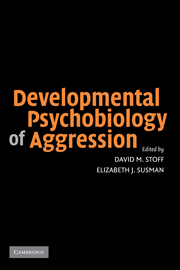Book contents
- Frontmatter
- Contents
- Foreword
- INTRODUCTION
- PART I PLASTICITY
- PART II BIDIRECTIONALITY
- PART III GENE–ENVIRONMENT INTERACTIONS
- 10 Toward an Integrative Account of the Development of Aggressive Behavior
- 11 How Gene–Environment Interactions Shape the Development of Impulsive Aggression in Rhesus Monkeys
- CONCLUSION
- Author Index
- Subject Index
- References
10 - Toward an Integrative Account of the Development of Aggressive Behavior
Published online by Cambridge University Press: 14 July 2009
- Frontmatter
- Contents
- Foreword
- INTRODUCTION
- PART I PLASTICITY
- PART II BIDIRECTIONALITY
- PART III GENE–ENVIRONMENT INTERACTIONS
- 10 Toward an Integrative Account of the Development of Aggressive Behavior
- 11 How Gene–Environment Interactions Shape the Development of Impulsive Aggression in Rhesus Monkeys
- CONCLUSION
- Author Index
- Subject Index
- References
Summary
To the memory of Robert B. Cairns
(1933–1999)“The reader who wants to study the best work on aggression in the second half of the 20th century will find most of it in the works of Bob Cairns.”
Tremblay 2000 p. 138Toward an integrative understanding of behavioral development, one sufficient to address how complex behaviors emerge over the course of development, the field of developmental psychobiology has advanced in recent years to transcend dichotomous views of cause and effect or nature versus nurture. Beyond parsing the stuff of life into genetic or environmental sources, contemporary theorists are likely to envision three-dimensional interactive webs, lifelines or fabrics of intertwined strands, recursive fractal forms, and dialectical transformations across levels of organization as conceptual models for aspects of developmental processes (Cairns, 1996; Gottlieb, 1998; Hood, 1995; Lerner, 1998; Michel & Moore, 1995; Thelen & Smith, 1998). Whether these models are generative in revealing new properties of specific developmental domains is an active question. For present purposes, they bring an expanding range of issues to the research agenda for a multidisciplinary approach to the study of development. A consideration of aggressive behavior as enfolded within a dynamic developmental manifold may contribute to the goal of a fully integrative account. This is the present project.
A critical issue for proceeding is how to construe the ubiquitous and continuous bidirectional flow of actions that comprise social interchanges. Social environments affect individual development even as individuals choose and shape their changing social environments.
- Type
- Chapter
- Information
- Developmental Psychobiology of Aggression , pp. 225 - 251Publisher: Cambridge University PressPrint publication year: 2005
References
- 6
- Cited by



